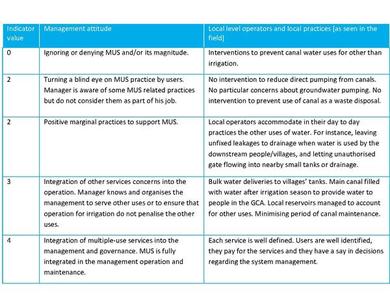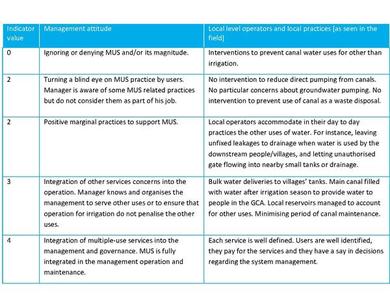Tool 5
TOOL 5. RAPID APPRAISAL PROCEDURE FOR MUS SYSTEM
To (help service providers) understand the way MUS is integrated or not in large scale irrigation and to better understand how far the infrastructure may allow improving the provision of multiple services to users.
The Rapid Appraisal Procedure (RAP) was developed for large-scale surface irrigation by FAO and partner institutions in the late 1990s. It is a one to two-week process of data collection and analysis for diagnosing the bottlenecks, performance and service levels within a large-scale irrigation system. The process provides a systematic examination of the hardware and processes used to convey and distribute water to all levels within the system (from the source to the users).
The RAP exercise is based on a number of Excel worksheets, allowing entry of data and automatic analysis according to pre-set indicators. RAP-MUS consists of these RAP worksheets plus an extra MUS-focussed worksheet. These will be down-loadable from the FAO website (www.fao.org).
OBJECTIVE
To (help service providers) understand the way MUS is integrated or not in large scale irrigation and to better understand how far the infrastructure may allow improving the provision of multiple services to users.
METHOD
Three internal indicators are considered in RAP-MUS:
- Number of water services: This indicator simply establishes the number of water services provided, intentionally or unintentionally, by a scheme. (See also step 1 of Tool 4).
- Degree of MUS integration: This indicator establishes the level of MUS integration into the management of a scheme and the way managers see multiple uses within the command area.
- Table 6 can be used for ranking MUS integration.
- Importance of each water service: This indicator ranks the importance of each water service provided by a scheme through a 0-4 ranking. The importance of each service should be assessed by the irrigation managers on the basis of absolute importance. They should consider alternative sources of water available for each water use, and the impact that removing canal irrigation would have on the service. Both quantity and quality of water have to be considered when rating for importance. See Table 7.
Table 6 - Ranking MUS integration in irrigation management, operation and practices

Source: Renault, et al., n.d.
Table 7 - Example of importance of water services in Vietnam (Bac Hung Hai Irrigation and Drainage Scheme in Kim Dong district)

Source: FAO, 2010.
The scores of these indicators can be determined through key information interviews with water users and service providers.
BASED ON
MASSMUS Step 1 in: Renault, D. et al., (n.d.). Multiple uses of water services in large irrigation systems, auditing and planning modernisation. The MASSMUS Approach. FAO ID 66, Rome: Food and Agriculture Organization of the United Nations.
